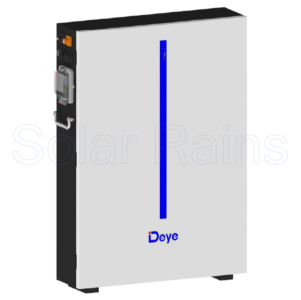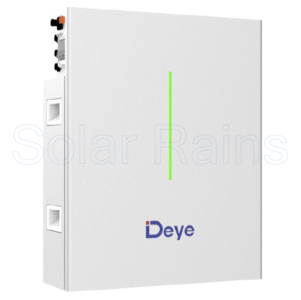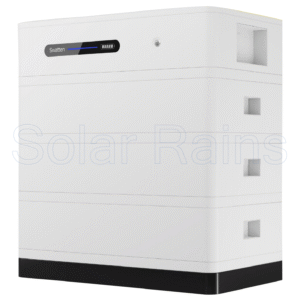Introduction
As more Australian households adopt solar energy, the need for reliable energy storage becomes increasingly important. A well-sized residential battery helps maximise solar usage, reduce grid reliance, and protect your home from blackouts.
But with a range of capacities from compact 5kWh units to large 20kWh systems, how do you know what battery size is right for you?
In this guide, Solar Rains walks you through everything you need to know about sizing a residential solar battery, so you can make a confident, informed decision for your home.
Understanding Residential Battery Storage
A residential battery stores excess solar power generated during the day, allowing you to use it at night or during grid outages. It complements your solar panels and can dramatically increase your energy independence.
Key Battery Metrics:
- kWh (kilowatt-hours): Measures how much energy the battery can store.
- kW (kilowatts): Measures how much power the battery can deliver at once.
- Depth of Discharge (DoD): Indicates how much of the battery’s capacity can be used.
- Cycle Life: Number of charge/discharge cycles the battery can handle before degrading.
Factors to Consider When Sizing a Residential Battery
Daily Energy Usage
The average Australian home uses 15–25 kWh per day. You can find your average usage on your electricity bill or use a smart meter.
Solar Generation Capacity
If you have a 6.6 kW solar system, you might generate 20–30 kWh/day depending on weather and location. A battery allows you to store any unused solar energy.
Backup Needs
Want to power essentials during blackouts? Choose a battery that can handle loads like:
- Fridge (~1.2 kWh/day)
- Lighting (~1 kWh/day)
- Wi-Fi/modem (~0.2 kWh/day)
- Medical equipment (varies)
- A 5–10 kWh battery may be sufficient for basic backup.
Grid Usage Preferences
If you want to go off-grid or rely minimally on the grid, opt for a larger battery (10kWh+). If you’re just looking to reduce evening electricity use, a smaller battery may suffice.
Common Residential Battery Sizes & Use Cases
| Battery Size | Suitable For | Typical Daily Usage Offset | Example Products |
| 5–6 kWh | Small households, limited budget, light backup | ~4–6 kWh | Deye 6.14kWh Battery |
| 10–13 kWh | Medium homes, evening usage, moderate backup | ~8–12 kWh | AlphaESS 10kWh All-in-One |
| 15–20+ kWh | Large homes, high consumption, near off-grid | ~14–20+ kWh | Dyness Commercial Battery |
For modular options that grow with your needs, consider Swatten Stackable Batteries, available in 9.6kWh or 12.8kWh units.
The Role of Hybrid Inverters in Battery Sizing
To maximise performance, your solar inverter must be compatible with your battery’s capacity and voltage. Hybrid inverters like the Swatten Hybrid 5kW/6kW manage both solar input and battery output efficiently.
Incompatible inverters may limit usable battery capacity or affect system lifespan.
Financial Considerations
Cost vs Benefit
While upfront costs can be high, residential batteries can pay off over time through:
- Reduced electricity bills
- Feed-in tariff optimisation
- Backup power
- Participation in Virtual Power Plants (VPPs)
Government Rebates
Many states offer rebates or incentives for installing residential batteries. For instance, the Cheaper Home Batteries Program and NSW Peak Demand Reduction Scheme.
Check with your local energy authority or consult Solar Rains for eligibility.
Questions to Ask Before Choosing a Battery Size
- How much energy do I use at night or during peak times?
- What appliances do I want to run during a blackout?
- How often do power outages happen in my area?
- Am I planning to expand my solar system in the future?
Expert Tip: Don’t Oversize Without Need
Bigger isn’t always better. An oversized residential battery that’s rarely used will have a longer payback time. Likewise, an undersized battery might leave you drawing from the grid sooner than expected.
Solar Rains recommends matching your system size with your consumption habits and factoring in future needs like EV charging or working from home.
How to Monitor & Optimise Your Battery Usage
Once installed, use your system’s app or portal to:
- Track battery state of charge
- Schedule loads (e.g., hot water or dishwasher) for optimal battery use
- Monitor solar production
- Set usage preferences (self-use, grid export, blackout reserve)
Maintenance & Warranty Considerations
Choose a solar battery with:
- At least a 10-year warranty
- Good cycle life (5000+ cycles)
- Remote monitoring options
- Reliable support from your solar supplier
Solar Rains partners only with reputable manufacturers and offers support on all solar products sold.
Choosing the Right Residential Battery Supplier
When evaluating solar power suppliers or installers, ask:
- Are you Clean Energy Council-accredited?
- Do you offer installation & after-sales service?
- Can you design a system tailored to my usage?
- Do your batteries include installation support?
Solar Rains is a trusted solar supplier based in Australia with expertise in custom energy storage solutions for both homes and businesses.
Conclusion
The right residential battery size depends on your energy usage, solar generation, backup needs, and financial goals. Whether you’re a light evening user or looking to go off-grid, there’s a solution for you.
Need help finding the perfect size? Our team at Solar Rains is ready to guide you. Explore our solar battery range or get in touch for a free consultation.
FAQs
Yes. Many modern systems use modular or stackable batteries. Just ensure your inverter supports expansion.
It depends on your load. It can run essential appliances (fridge, lights, Wi-Fi) for 12–24 hours.
Usable capacity accounts for the battery’s depth of discharge. A 10kWh battery with 90% DoD gives 9kWh usable energy.
Yes, but you’ll need sufficient battery size and inverter output. A split system may use 1–2.5 kWh per hour.
Typically, a 10–13kWh battery balances capacity and cost well for most 6.6kW setups.














